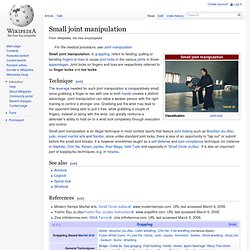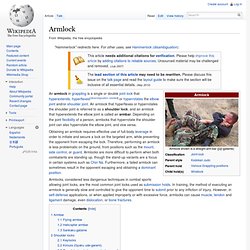

Wristlock. The wristlock is a technique that can be applied from a stand-up position, simply by grabbing the opponent's hand and twisting and/or bending it in a non-natural direction.

It is considered to be a relatively safe technique to practice with a willing opponent,[4] but if applied suddenly and/or forcefully, a wristlock can cause ligament tears or possibly even dislocation or bone fractures. Mixed Martial Arts organizations usually allow wrist locks but they are almost never performed due to the MMA gloves and wrist wraps which stabilize the wrist. Wrist locks are also seen as being easy to defend against and often leave the attacker vulnerable to punches and elbow strikes. One notable use of a wristlock was by Royce Gracie against Akebono Taro.
Major methods of wrist manipulation[edit] Rotational wristlock[edit] Rotational wristlock by an Aikido instructor Supinating wristlock[edit] A supinating wristlock demonstrated. Spinal lock. Spinal locks can be separated into two categories based on their primary area of effect on the spinal column: spinal locks on the neck are called neck cranks and locks on the lower parts of the spine are called spine cranks.

Primarily a feature of some martial arts and wrestling, a 2007 news article reported the dangerous use of spinal locks in Australia's National Rugby League.[1] Neck crank[edit] A neck crank (sometimes also referred to as a neck lock, and technically known as a cervical lock) is a spinal lock applied to the cervical spine causing hyperextension, hyperflexion, lateral hyperflexion, hyperrotation or extension-distraction, either through bending, twisting or elongating. A neck crank is typically applied by pulling or twisting the head beyond its normal ranges of rotation. Can opener[edit] Cattle catch[edit] Crucifix neck crank[edit] The crucifix neck crank is similar to the cattle catch, but involves the combatant performing the neck crank being mounted on the opponent.
Small joint manipulation. For the medical procedure, see Joint manipulation Small joint manipulation, in grappling, refers to twisting, pulling or bending fingers or toes to cause joint locks in the various joints in those appendages.

Joint locks on fingers and toes are respectively referred to as finger locks and toe locks. Technique[edit] The leverage needed for such joint manipulation is comparatively small, since grabbing a finger or two with one or both hands creates a distinct advantage. Joint manipulation can allow a weaker person with the right training to control a stronger one.
See also[edit] Leglock. As with other jointlocks, leglocks are more effective with full body leverage.

Some attack the large joints of the knee or hip and involve utilizing leverage to counteract the larger muscle groups, while others directly attack ligaments in the knee or the smaller joint of the ankle. Leglocks can involve control positions such as the inside leg triangle or leg knot to maintain control while applying the attack or transitioning between two attacks, though they and some other control positions are banned in Brazilian Jiu-jitsu competition. Some other leglock control positions have been adopted into modern BJJ and submission grappling competitions as "guards" such as the snake guard, one-legged X-guard, and 50/50 Guard, where they are used for both leglocks and to reverse into dominant positions from the bottom. Some examples of the many types of leglocks are found below. Kneebar[edit] A kneebar is performed on the leg similarly to how the armbar is performed on the arm.
Armlock. Armbar[edit] A fighter attempts to escape from an armbar by slamming the opponent to the ground.

Judo black belt applying a jūji-gatame (armbar) against her opponent. Flying armbar[edit] The flying armbar is a version of the jūji-gatame that is performed from a stand-up position. Without a gi, it is typically applied when the opponent has a collar tie. Helicopter armbar[edit] The helicopter armbar is a little different version of the armbar, a combination of an armbar and tomoe nage, which is also used by wrestling, Judo and BJJ.
Sankaku-gatame[edit] The sankaku-gatame or "triangular armlock" is a jūji-gatame performed from the sankaku position.